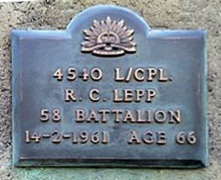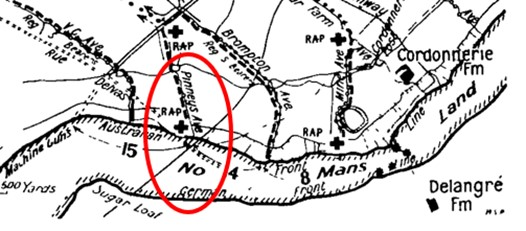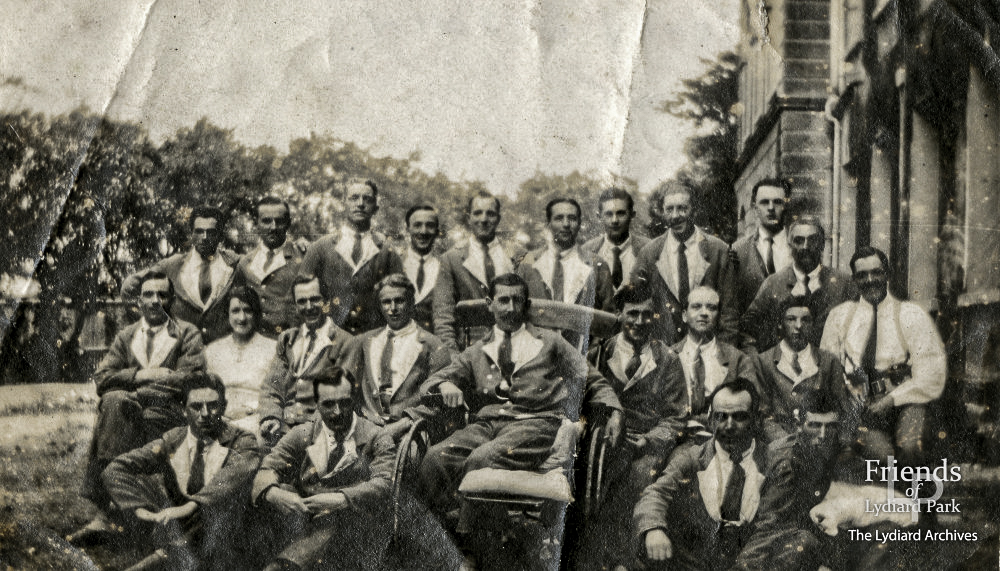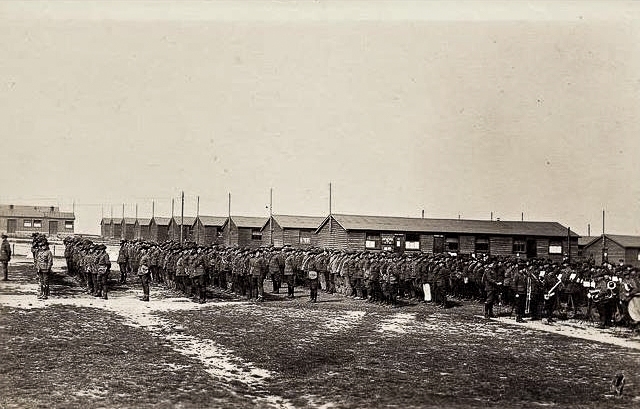Reginald Charles LEPP
Eyes grey, Hair brown, Complexion fair
Aussie Soldiers of Chinese Ancestry – one of the Lepp families of Ballarat
Two Lepp families from Ballarat contributed six sons in support of the Great War – three from George Lepp’s family and three from his brother James’. The Lepp families continued to support the military with four sons and daughters serving in the Second World War. Below is the story of George Lepp’s sons and we would like to thank The Museum of Chinese Australian History, Melbourne (The Chinese Museum) for their support for this story.
Margaret (nee Hin-Yee) and George Edward Lepp had eight children (one daughter, seven sons), although one son died young. Both Margaret and George were of Chinese ancestry with George’s family arriving in the early 1800’s, long before the Ballarat gold rush.
Three of their sons served in the War - Albert Edward, born in 1892, Reginald Charles (Reg), in 1894 and Arthur Norman (Norm) in 1896. All were born in Ballarat, Victoria.
The boys attended the Golden Point School on the southeast side of Ballarat. Albert and his older brother Ernie were members of the Gymnastics Club, and it’s likely that Reg and Norm were gymnasts as well as their cousins were also members. Lepp family involvement in sport must have been even wider than just gymnastics as their father George was the first Chinese Australian Rules umpire in a match that was played on Friday 26 August 1892 and Albert’s grave in France has had current-day poppies placed there by the Golden Point Rugby Club.
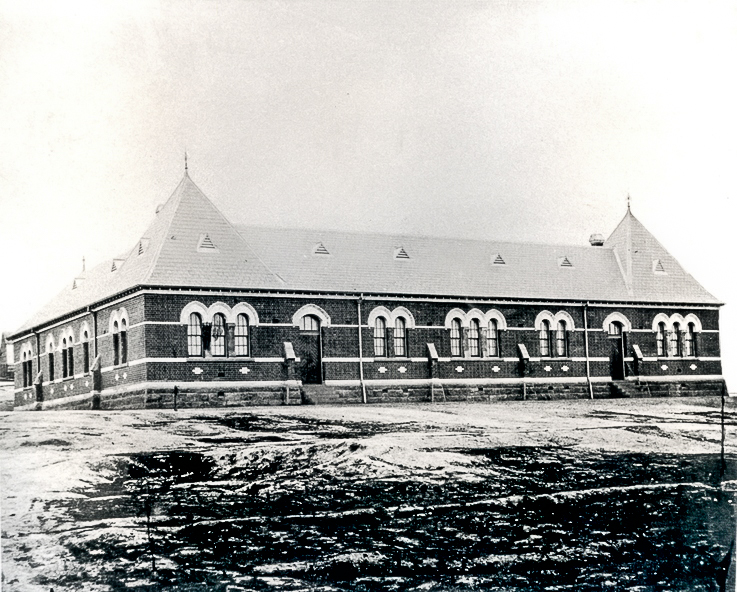
After their schooling was completed, Albert became a farmer, Reg a farm labourer and Norm a boot maker. All three were single when the War broke out.
Brothers in Arms
Reg, aged 21, was the first to enlist, 12 July 1915 with Albert, 23, following four days later. Norm, 19 years-old, enlisted in February 1916 just days after his two older brothers left Australia with their battalion.
Albert and Reg were initially assigned to the 14th reinforcements of the 8th Battalion and given consecutive service numbers. While still in Melbourne, Albert was assigned as an acting Corporal.
With the need for troops in Egypt and Europe, Albert and Reg embarked on the HMAT A32 Thermistocles on 28 January 1916 in Melbourne, Victoria for the one-month trip. They disembarked at Suez at the end of February.
The 8th Battalion had been fighting in Gallipoli, but they were evacuated to Egypt in December 1915. When Albert and Reg’s group of reinforcements arrived, the 8th were in Serapeum at the Suez Canal. Training activities for the soldiers included route marches and shooting practised in “dusty, disagreeable” weather, per the Battalion reports.
At the end of March, the 8th Battalion was to head out to the Western Front but with all the new recruits arriving in Egypt, major reorganizations were going on. Albert and Reg were reassigned to the newly formed 58th Battalion. In the reshuffle, however, Albert was returned to the rank of Private.
The two Lepp brothers then remained in Egypt with the 58th training and guarding the Suez Canal at Ferry Post and Hogsback. By early June, the Battalion was at a total strength of over 1000 men.
To the Western Front
On 13 June 1916, Lord Kitchener read the orders from the King to the Battalion for them to provide support on the Western Front. They moved to Alexandria on 17 June to board the H7 Transylvania and arrived in Marseilles on the 23rd. From there, they had a three-day train ride to Steenbecque, 35 kilometres from Fleurbaix. Albert and Reg weren’t the only family to have been in the area. Their cousins Clarence and Jim had been in Fleurbaix in April when the 24th Battalion spent some time there.
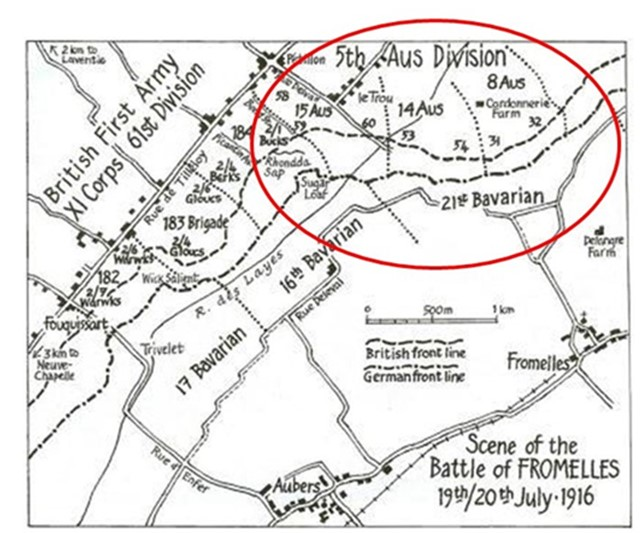
After marching to Fleurbaix and undergoing further training, including the use of gas masks, they were into the trenches for the first time on 11 July. The 58th Battalion’s Corporal Bill Boyce (3022) summed up his reaction to the situation well:
“What have I let myself in for?”
The 58th’s role in the battle was to be in support of the 59th and 60th - carrying ammunition, digging the communication trenches for area gained in No Man’s land and relief as needed for the attack.
The initial charges made by the 59th and 60th began at 6:45pm on 19 July. There was intense fire from rifles and the machine guns at the Sugar Loaf salient just a short distance away, as well as ongoing bombardment. Heavy losses were immediate and the 58th was called in for support. They were into the action by 10:00pm.
Albert was a bomber (grenades) and his unit entered No Man’s Land at the end of “Pinney’s Avenue” (map below). Private Frederick Ford (4491) reported it was “very dangerous” and that Albert and Joseph Ernest Ryan (4576) went “well on”.
Reg’s experiences in the battle are not documented, but the whole of the 58th were in the thick of it.
Fighting continued through the night. By 6:00am what was left of the 58th had left the trenches and were relieved by the 57th. Of the 1002 men of the 58th Battalion that left Egypt, the roll call reflected 27 killed, 167 wounded and 53 missing. Albert was among the missing. The losses in the 59th and 60th were much higher.
The next several days were spent trying to recover the wounded, under sniper fire, and burying the dead. While there were no further attacks, the 58th remained in the vicinity of Fleurbaix until the end of August 1916.
Albert’s Fate
The family was quickly notified of Albert being “missing in action”, but no further information was available, and the family was understandably anxious.
Given that Albert and Reg were in the same Battalion, there was potential for confusion as further information came in. And sadly, this confusion came to pass.
An initial report was received in November 1916 from a Ballarat soldier, Leslie L. Thomas (2446), who knew of a “chap of that name” in his company but, rather than being missing in action, Thomas said that he saw Lepp on 9 October. However, he was not sure of that soldier’s first name or number but said he would ask his mates. Albert’s mother requested the Army send her Thomas’ contact details so she could reach out to his family for more information.
Later, several other witnesses also provided input, one even citing having seen Albert in hospital in England and later seeing Lance Corporal Lepp in the unit. It was Reg who had been promoted to Lance Corporal on 29 September 1916.
More definitive statements did not come to light until 27 July 1917, more than a year after Albert was reported missing.
Lieutenant John William Craze saw Albert being hit, presumably by shell fire, and falling. Sergeant Edward Joseph Hannan (3307) went to his assistance, but “found that he was quite dead.” They were unable to bring his body in at the time due to the heavy enemy fire.
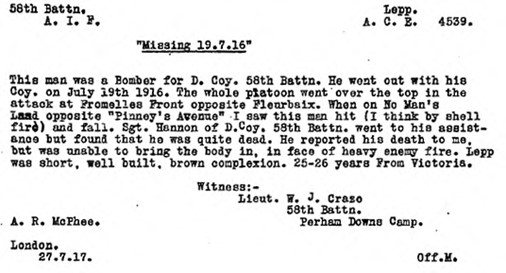
A Court of Enquiry in the Field was held on 1 September 1917 which declared Albert as Killed in Action.
Nearly four years later when the graves in the field were exhumed, Albert’s body and ID disc were found. His mother was notified on 30 June 1920 and his ID disc was sent to her later.
Albert’s remains now rest in the Ration Farm Military Cemetery (Plot VI, Row J, Grave No. 44), La Chapelle d'Armentieres, France. The blue and white “poppies” at the bottom of the headstone are from the Ballarat Golden Point Rugby Club.
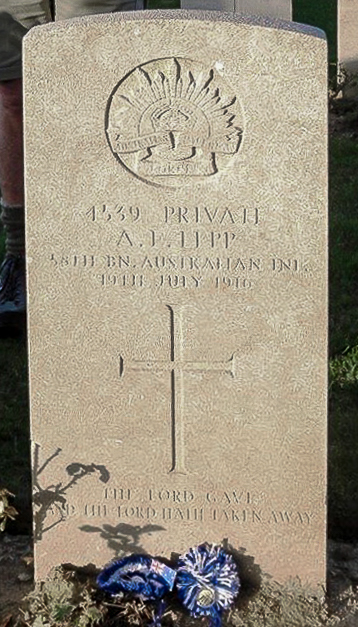
Reg Has to Move On – but is Wounded, Twice
The loss of a brother in battle does not stop the war and Reg had to move on. After Fleurbaix, the 58th were moved north towards Belgium, supporting the advance that followed the German retreat to the Hindenburg Line.
In May 1917, they were engaged in the second Battle of Bullecourt, Belgium. There were two weeks of bitter trench fighting which came at the cost of 2,250 Australian casualties, but they did clear, and hold, part of the Hindenburg Line. On 12 May, early in the battle, Reg was shot in his right hand. He was sent to the Rouen General Hospital and then to the 2nd Birmingham Hospital in England for treatment.
After he was released in late June, Reg was granted a one-month furlough and then was assigned duties at the Command Depot. In November 1917, he re-joined his unit.
A major German offensive on the Western Front began in late March 1918. The 58th Battalion was brought in to fight at Villers-Bretonneux. This battle is notable for being the first occasion on which tanks fought against each other.
On 10 April 1918, Reg was moved into billets at Fouilloy, 16 kilometres east of Amiens. Artillery barrages were ongoing and there was extensive gas shelling in the area.
After what was now years of fighting (and with dreary April weather), small pleasures were hard to come by. When the canteen was reopened for the soldiers of the 58th, it was noted that tobacco and cigarettes had been in short supply and “the men are feeling the scarcity severely”. Another highlight for the troops in the area was the 21 April 1918 downing of the “Red Baron”, whom the nearby 53rd had been firing on.

The battle was looming, however, and at 3:50am on 24 April, all men were “standing to” readying for an attack on the Germans. The 59th and 60th were to carry out the attack with the 57th for close support and the 58th in reserve. The orders did not come through until that evening, but by early in the morning of the 25th it was reported that the Aussies had been successful and by 4:40am the 58th were moving forward. Air attacks and heavy shelling of the forward areas were ongoing.
On 27 April, the 58th and 60th were to lead the attack. By 7:50am, the Germans were nearby and were reported as attacking the 60th in “dense masses” and digging in. By 1:45pm, however, the Germans were beginning to retreat. In the fighting during the day, Reg was wounded - again – this time more seriously with gunshot wounds to his left leg and left foot.
On 29 April, Reg was moved from the aid stations to the hospital in Etretat on the coast of France and on 3 March 1918 he was sent for treatment at the Kitchener Military Hospital in Brighton, England. His family was kept posted about his injury and his recovery.
By 28 May 1918, Reg was removed from the seriously ill list. He remained in England at the Command Depot in Weymouth for convalescence until he boarded the Hospital Transport ship Manhattan for his to return to Australia. Reg left England on 6 November 1918 and arrived in Melbourne on New Year’s Day 1919. Lance Corporal Reg Lepp was discharged on 2 May 1919.
Norm’s War
While Norm enlisted in February 1916, he was not sworn in until 10 August and less than a week later embarked to England. He was assigned to the 39th Battalion. He arrived in England in early October and, given he had little training in Australia, was assigned to the 8th Training Battalion in Codford, England.
In early February 1917, just 20 years old, Private Norm Lepp was on his way to the Western Front. He joined the 39th Battalion on 25 March in their ongoing training exercises in Difques, France, 36 kilometres from Calais.
The 39th spent April and May in training at locations near the front preparing for the major British offensive in Flanders. The first engagement for the 39th Battalion was the battle of Messines.
By 3 June, Norm was in Oosthove, Belgium, 14 kilometres from Messines. On the 4th, the Germans began gassing the area and the “effect of gas (was) felt very much”.
On 6 June, they moved into the lines at Ploegsteert Wood at 11:42pm, with the zero hour being planned for 3:10am on 7 June. They successfully gained their objectives within the first hours of the battle, although they were badly gassed - 299 wounded, 24 killed, 145 missing. The 39th was relieved at 5am on 9 June.
Norm was among those gassed and on 9 June he was moved to the Canadian Hospital, Etaples for treatment. He remained under treatment in several locations along the coast of France until 21 August when he was sent to Perham Down, Andover, England, one of four Australian command depots in the UK dealing with soldiers who had been discharged from hospital.
Given Norm’s poor condition, however, he was sent home. He left England on 26 September 1917 on Hospital Transit ship A30 Borda. He arrived in Australia on 21 November 1917 and was discharged on 18 February 1918.
After the War
Reg married Eileen May Fitzpatrick and they had one child. He was a munitions worker. He passed away on 14 February 1961 and is buried in Altona Memorial Park, Altona, Victoria - Fountain Court, Wall WA, Niche 43.
Norm married Louise Tessa Whittle in 1922 and they had one son. He held jobs as a rubber worker and a cabinet maker. He died on 31 Dec 1970 and is buried in Fawkner Memorial Park, Moreland, Victoria - Garden of Remembrance 3 Wall Niches, Section 4, Wall G, Niche 152.
All three Lepp sons received the British War Medal and the Victory Medal, Albert’s being sent to his mother, Margaret Lepp, as next of kin.
Ballarat has an active commemorative program. Their Avenue of Honour began in 1917 and now extends 22 kilometres and contains 3771 trees in memory of their local soldiers. Albert Lepp’s tree stood tall until October 2021, when it was blown down by a massive storm. His memory lives on, however. Members of the 8th/7th Battalion Royal Victoria Regiment based at the Ballarat Ranger Barracks decided to use the timber from Albert’s tree in a meaningful way, creating memorial picture frames.

In addition, all of the streets in the suburb of Lucas have been named to honour local World War One soldiers who lost their lives. Lepp Street honours Albert and his cousin Victor.
The whole of the Lepp family and the Chinese Community of Ballarat can be very proud of their Australian sons. As written in Albert’s obituary:
DUTY NOBLY DONE.
The Fromelles Association would love to hear from you

Contacts
(Contact: royce@fromelles.info or geoffrey@fromelles.info).
(Contact: army.uwc@defence.gov.au or phone 1800 019 090).
Donations
If you are able, please contribute to the upkeep of this resource.
(Contact: bill@fromelles.info ).
